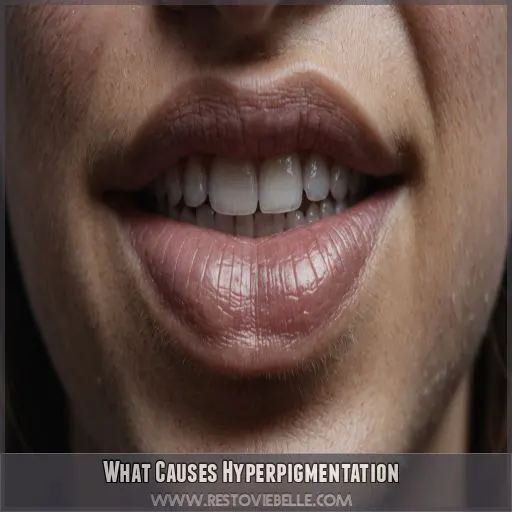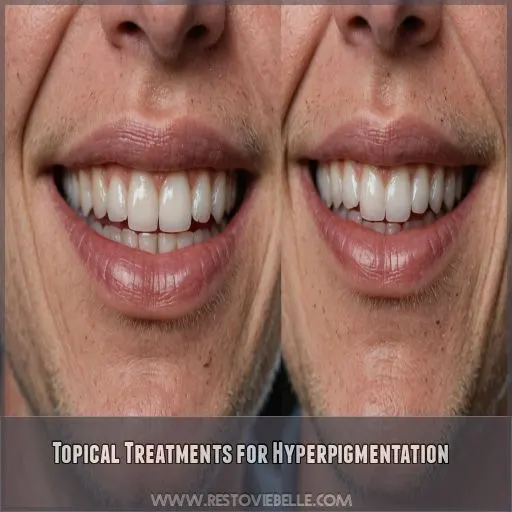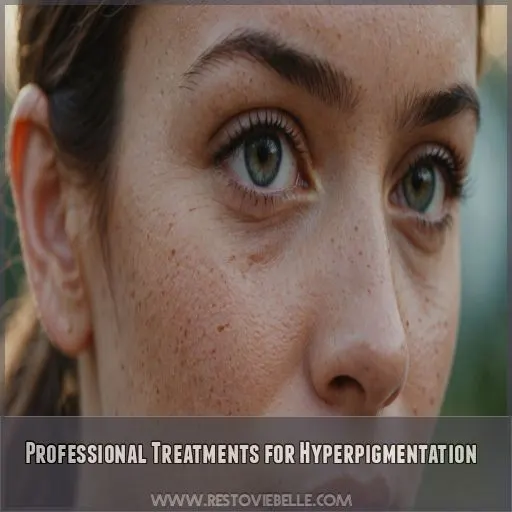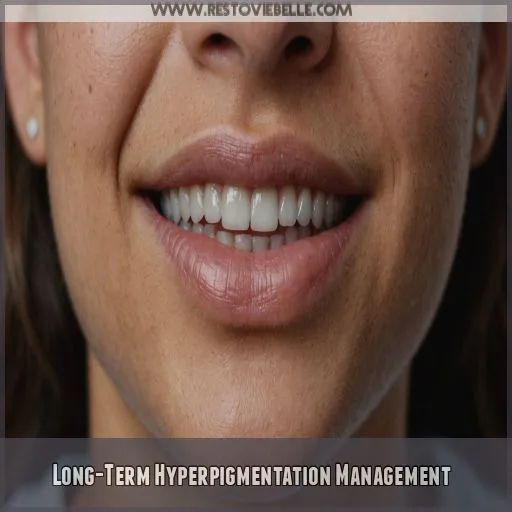This site is supported by our readers. We may earn a commission, at no cost to you, if you purchase through links.
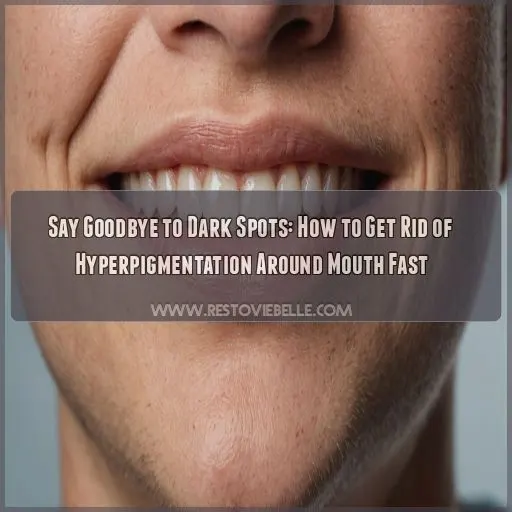
Don’t worry, you can show them the door with a combo of at-home treatments and professional help.
First, try using skin brightening creams and serums containing niacinamide, vitamin C, or licorice extract to lighten up the area.
For more stubborn spots, consider chemical peels, microdermabrasion, or laser therapy.
And don’t forget to wear sunscreen daily and eat a balanced diet rich in Vitamin C to prevent future hyperpigmentation.
Table Of Contents
- Key Takeaways
- What Causes Hyperpigmentation
- Topical Treatments for Hyperpigmentation
- Professional Treatments for Hyperpigmentation
- Lifestyle Changes to Prevent Hyperpigmentation
- Long-Term Hyperpigmentation Management
- Frequently Asked Questions (FAQs)
- Does hyperpigmentation around the mouth affect only certain skin types?
- Can hyperpigmentation around the mouth be a sign of a serious health condition?
- How does hyperpigmentation around the mouth impact a persons mental health?
- Can hyperpigmentation around the mouth be treated with home remedies?
- Is hyperpigmentation around the mouth a permanent skin condition?
- Conclusion
Key Takeaways
- You can tackle hyperpigmentation around your mouth by combining at-home treatments, such as skin-brightening creams and serums, with professional help from chemical peels or laser therapy – just be patient and consistent!
- To prevent future hyperpigmentation, prioritize sun protection (your skin’s best friend!), a balanced diet rich in vitamin C, and stress management – because less stress equals more glow!
- Hormonal changes, sun exposure, inflammation, and genetics can all contribute to hyperpigmentation around your mouth, so understanding the underlying causes will help you create a personalized treatment plan that really works.
- It’s time to debunk the myth that hyperpigmentation around the mouth is a permanent skin condition – with the right treatments and self-care, you can regain control over your skin tone and say goodbye to those pesky dark spots for good!
What Causes Hyperpigmentation
You’re probably no stranger to those pesky dark spots around your mouth, but have you ever wondered what causes them? Hyperpigmentation can be triggered by a combination of factors, including hormonal changes, sun exposure, inflammation, and even your genetic makeup, so let’s break it down and explore what’s behind those unwanted dark spots.
Hormonal Changes and Hyperpigmentation
Hormonal changes can wreak havoc on your skin, causing hyperpigmentation around the mouth. You’re not alone – many women experience this during pregnancy, menopause, or while taking birth control. Even thyroid issues and stress can trigger it. Here are 3 key hormonal changes to watch out for:
- Pregnancy hormones: Fluctuations in estrogen and progesterone can cause dark spots.
- Menopause: Decreased estrogen levels can lead to skin discoloration.
- Thyroid issues: Hormonal imbalances can cause hyperpigmentation, so get your thyroid checked!
Sun Exposure and Skin Damage
Here’s the deal: sun exposure is a major contributor to hyperpigmentation. Think about it – when you get a sunburn, your skin goes into overdrive, producing more melanin to protect itself. This can lead to dark spots. So, make SPF your BFF! Use it daily, and ditch those tanning beds – they’re a skin cancer waiting to happen.
Inflammation and Hyperpigmentation
If you’re dealing with hyperpigmentation, inflammation is like that unwanted guest who just won’t leave. Here’s how it can lead to dark spots:
- Acne and the resulting inflammation can cause post-inflammatory hyperpigmentation (PIH).
- Skincare routine mistakes, like over-exfoliating, can lead to irritation and inflammation.
- A diet high in processed foods can trigger inflammation in the body.
- Stress can also cause inflammation, which may worsen hyperpigmentation.
Other Triggers and Risk Factors
Beyond inflammation, other sneaky triggers can cause hyperpigmentation. Certain skin conditions like acne, eczema, or psoriasis can lead to dark spots. Some medications, like birth control or chemotherapy, can also cause hyperpigmentation. Your diet, age, and stress levels can even play a role. So, it’s important to be aware of these potential triggers to take control of your skin.
Genetics and Hyperpigmentation
Genetics can play a significant role in hyperpigmentation. If your family members have struggled with dark spots, you might be more prone to them too. Your genetic predisposition can affect melanin production, leading to skin tone variations. People with darker skin tones, especially those with African or Asian heritage, are more likely to experience hyperpigmentation due to ethnic differences.
Topical Treatments for Hyperpigmentation
You’re one step closer to saying goodbye to those pesky dark spots around your mouth – now it’s time to explore the best topical treatments for hyperpigmentation. From skin brightening creams and serums to hydroquinone and retinoid treatments, we’ll break down the most effective options to help you achieve a more even-toned complexion.
Skin Brightening Creams and Serums
Skin brightening creams and serums can help reduce hyperpigmentation around your mouth. When choosing a product, look for these key ingredients:
- Niacinamide, which improves skin elasticity and brightness
- Vitamin C, which boosts collagen production and fades dark spots
- Licorice extract, which soothes and calms the skin
Remember to always follow application tips and be patient – results may take a few weeks!
Hydroquinone and Retinoid Treatments
Time to bring in the big guns! Hydroquinone and retinoid treatments can be super effective in fading hyperpigmentation around your mouth. However, be aware of potential side effects like skin irritation, redness, or dryness. To minimize risks, follow the product’s dosage guidelines, start with a lower concentration, and gradually increase as your skin becomes more tolerant.
Vitamin C and Niacinamide for Hyperpigmentation
Time to bring in the big guns – Vitamin C and Niacinamide! These two powerhouses can help brighten and even out your skin tone. Here are three ways to harness their power:
- Use a Vitamin C serum: Boost collagen production and fight off dark spots with a few drops of this miracle worker.
- Unlock Niacinamide benefits: Improve skin elasticity and reduce inflammation with this B3 derivative.
- Combine them in a skin brightening routine: Mix and match products or create a DIY mask to supercharge your skin care.
Natural Remedies for Hyperpigmentation
You’re looking for some natural remedies to tackle hyperpigmentation. Try DIY masks with aloe vera, which can help soothe and brighten your skin. Lemon juice, rich in vitamin C, can also lighten dark spots. Mix turmeric paste with essential oils like tea tree oil for an anti-inflammatory boost. Just remember to patch test before applying any new treatments!
Professional Treatments for Hyperpigmentation
You’ve tried topical treatments, but those stubborn dark spots around your mouth just won’t budge – it’s time to bring in the big guns: professional treatments for hyperpigmentation. A dermatologist or skincare professional can help you choose the best treatment, whether it’s a chemical peel, laser therapy, or microneedling, to help you say goodbye to hyperpigmentation for good.
Chemical Peels and Microdermabrasion
Now that we’ve covered topical treatments, let’s talk about taking it to the next level with professional help. Chemical peels and microdermabrasion can be game-changers for hyperpigmentation around the mouth. Here are some key things to keep in mind:
- Chemical peel recovery time can range from a few days to a week
- Microdermabrasion frequency is typically every 4-6 weeks
- Chemical peel vs microdermabrasion: peels are more intense, while microdermabrasion is gentler
- Cost comparison: peels can be more expensive, but also more effective
Laser Therapy for Hyperpigmentation
Let’s talk laser therapy for hyperpigmentation. You’ve got options like ablative and non-ablative lasers, with varying costs (think $500-$2,000 per session). Side effects are usually mild, but recovery time can range from a few days to a week. Results can last several months to a year or more, depending on your skin type and sun protection habits.
Microneedling and Radiofrequency Treatments
Let’s explore another professional treatment option: Microneedling and Radiofrequency Treatments. This minimally invasive procedure uses tiny needles to create micro-injuries, stimulating collagen production and improving skin texture. It’s often combined with radiofrequency energy to enhance results.
- Treatment cost: Around $500-$1,500 per session
- Procedure details: Typically 30-60 minutes, with 3-6 sessions recommended
- Recovery time: 1-3 days of mild redness and sensitivity
- Best candidates: Those with mild to moderate hyperpigmentation
- Long-term effects: Improved skin texture and reduced hyperpigmentation
Professional Skin Care Routines
Now that you’ve tried microneedling and radiofrequency treatments, it’s time to boost your results with a professional skin care routine. Invest in products recommended by your dermatologist and commit to regular visits. Treatment frequency and cost will vary, but customizing your routine will pay off. Think of it as a personalized playbook for tackling hyperpigmentation – and winning!
Lifestyle Changes to Prevent Hyperpigmentation
To tackle hyperpigmentation around your mouth, you’ll need to make some lifestyle changes that’ll help reduce those pesky dark spots and also improve your overall skin health. By incorporating sun protection, a balanced diet, stress management, and quitting smoking into your daily routine, you’ll be saying goodbye to hyperpigmentation in no time .
Sun Protection and Prevention
Now that we’ve covered professional treatments, let’s talk sun protection and prevention. When it comes to hyperpigmentation, the sun isn’t your friend. Here are some sun-savvy tips:
- Use broad-spectrum sunscreen with at least SPF 30 daily, even on cloudy days.
- Don’t believe the SPF myths – higher isn’t always better.
- Choose sun-safe makeup and moisturizers.
- Be extra cautious during peak sun hours (10am-4pm).
Healthy Diet and Hyperpigmentation
Let’s get real – your diet can either be a skin-saver or a hyperpigmentation trigger. Foods rich in Vitamin C, like berries and leafy greens, can brighten your complexion, while processed foods and sugary drinks can dull it. Stay hydrated by drinking plenty of water, and limit foods that can cause inflammation, like dairy and gluten.
| Skin-Friendly Foods | Foods to Avoid |
|---|---|
| Leafy greens (spinach, kale) | Processed meats (hot dogs, sausages) |
| Berries (blueberries, strawberries) | Sugary drinks (soda, sports drinks) |
| Nuts and seeds (almonds, sunflower seeds) | Dairy products (milk, cheese) |
| Fatty fish (salmon, tuna) | Refined carbohydrates (white bread, pasta) |
| Sweet potatoes | Fried foods (fries, fried chicken) |
Stress Management and Skin Health
Stress less, glow more! When you’re frazzled, your body pumps out stress hormones that can trigger hyperpigmentation. Prioritize sleep, a balanced diet, and mindfulness to keep your skin (and mind) calm. Regular exercise and relaxation techniques like meditation or yoga can also help regulate your hormones and promote a more even-toned complexion. Your skin will thank you!
Quitting Smoking and Hyperpigmentation
Quitting smoking is a total game-changer for your skin! Smoking cessation can greatly improve oral health and skin texture, giving you a collagen boost. The long-term effects of smoking can lead to wrinkles, age spots, and hyperpigmentation. By kicking the habit, you’ll be saying goodbye to dark spots and hello to a brighter, healthier complexion.
Long-Term Hyperpigmentation Management
You’ve made it to the final stretch: managing hyperpigmentation for the long haul. Now that you’ve tackled the causes, treatments, and lifestyle changes, it’s time to learn how to maintain your progress, combine treatments for the best results, and set realistic expectations for a brighter, more even-toned complexion.
Maintenance and Prevention Strategies
Now that you’ve made lifestyle changes to prevent hyperpigmentation, it’s time to think long-term. To maintain your progress, stick to a consistent skincare routine, prioritize sun protection, and be picky about product selection. Healthy lifestyle habits, like a balanced diet and regular exercise, also play a big role. Schedule regular checkups to catch any issues before they become major concerns.
Combining Treatments for Best Results
To tackle hyperpigmentation around your mouth, combine treatments for a one-two punch.
Pair topical creams with professional treatments like chemical peels or laser therapy for a cost-effective approach.
A personalized combo can minimize potential side effects and maximize long-term outcomes.
Think of it like a recipe: mix and match ingredients to create your perfect blend for a brighter, more even-toned smile.
Monitoring Progress and Adjusting Treatment
Now that you’re combining treatments, you really need to monitor your progress and adjust as needed. Patience is key – it can take several months to a year or more to see significant results. Keep track of your treatment timeline with:
- Regular spot checks in the mirror
- Progress photos to track changes
- Scheduled follow-ups with your doctor
- A journal to note any changes or concerns
- Your doctor’s advice on when to adjust your treatment plan
Realistic Expectations and Patient Satisfaction
Managing hyperpigmentation is a marathon, not a sprint.
Be patient and prepared for varying results – it can take several months to a year or more to see noticeable improvements (Source).
Understand the treatment timeline, costs, and potential outcomes to set realistic expectations (Source).
Educate yourself and choose a trusted provider to make sure you have a satisfying journey to brighter, more even-toned skin.
Frequently Asked Questions (FAQs)
Does hyperpigmentation around the mouth affect only certain skin types?
Hyperpigmentation around the mouth can affect anyone, but people with darker skin tones are more prone to it (Source). If you have a darker skin tone, you’re not alone – there are ways to address it!
Can hyperpigmentation around the mouth be a sign of a serious health condition?
About 50% of women experience hyperpigmentation during pregnancy, but did you know it can also signal underlying health issues? Don’t panic! In rare cases, mouth hyperpigmentation can be a sign of conditions like Addison’s disease or vitamin deficiencies.
How does hyperpigmentation around the mouth impact a persons mental health?
Hyperpigmentation around the mouth can affect your mental health, making you self-conscious and anxious about your appearance. You may feel like hiding behind layers of makeup or avoiding social events, which can lead to feelings of isolation .
Can hyperpigmentation around the mouth be treated with home remedies?
You can treat hyperpigmentation around the mouth with home remedies like lemon juice, aloe vera, and oatmeal scrubs . These natural ingredients can help lighten dark spots and even out your skin tone .
Is hyperpigmentation around the mouth a permanent skin condition?
Don’t worry, hyperpigmentation around your mouth isn’t a permanent resident – it can fade with the right treatments and a bit of patience . You can regain control over your skin tone with professional help and self-care.
Conclusion
Did you know that over 80% of women experience hyperpigmentation at some point in their lives?
You’re not alone in the battle against those pesky dark spots around your mouth!
By combining at-home treatments like skin brightening creams and serums with professional help from chemical peels or laser therapy, you can say goodbye to hyperpigmentation around your mouth for good.
Stay consistent, patient, and committed, and you’ll be on your way to a brighter, more even-toned smile.
Learning how to get rid of hyperpigmentation around your mouth is easier than you think!

